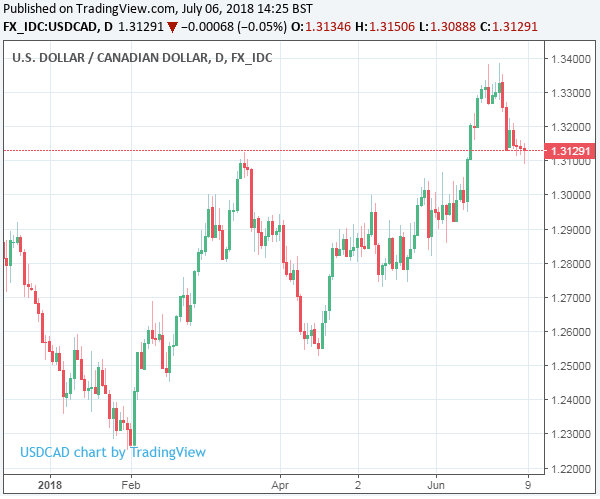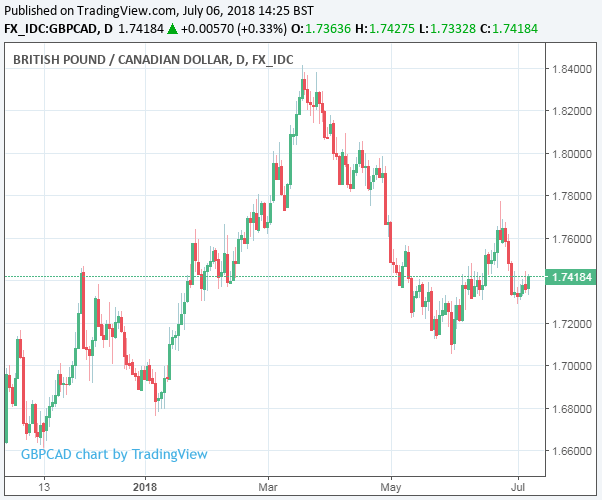The Canadian Dollar Losses Deepen after Jobs Data Does Little to Perk Up Bank of Canada Outlook
- Written by: James Skinner
-CAD falls as "trade war", oil prices and mixed jobs data all weigh.
-Jobs grow 31.8k but rising participation pushes unemployment to 6%.
-CAD risk is to downside as BoC is priced in and trade threat is growing.

© Pavel Ignatov, Adobe Stock
The Candian Dollar extended losses against its developed world rivals Friday after traders responded to a mixed June jobs report by offering the Loonie lower, as the data appears to have done little to improve the outlook for those hoping the Bank of Canada will continue raising interest rates after next week's meeting.
Canada's economy created 31,800 new jobs during June, up from a -7,500 contraction in May, which was far ahead of the consensus for jobs growth of 22,300. However, the unemployment rate posted a surprise increase during the recent month, rising from 5.8% to 6%.
Statistics Canada says the increase in the unemployment rate is due to changes in the level of participation, with more previously-discouraged workers enetering the labour force once more in June. This can increase the number of workers who are classed in the statistics as being unemployed without there actually being an increase in actual job losses.
However, much of this jobs growth was seen in the public sector and not the more-important private sector, while the number of part-time workers grew much faster than the number of full-time workers, suggesting "underemployment" may still be a problem for the Canadian economy. Barely a third of jobs created in June were full-time positions.
"A higher unemployment rate coinciding with a strong jobs gain in June is the best of possible worlds for Canada, with more of us working, but perhaps a bit more room for that to continue without triggering an inflation spike," says Avery Shenfeld, chief economist at Toronto-based CIBC Capital Markets. "Overall, not great in the details, but good enough for the Bank of Canada to hike rates in July."
Markets care about the labour market data because falling unemployment and improving job creation, according to conventional thinking on the subject, put upward pressure on wages. Wage growth itself leads to increased demand within an economy and exerts upward pressure on inflation, which has implications for interest rates and financial markets.
Changes in interest rates, or hints of them being in the cards, are only made in response to movements in inflation but impact currencies because of the push and pull influence they have on international capital flows and their allure for short-term speculators.
"With markets already priced for a hike by the BoC next week, the jobs number may hold little relevance for CAD," says Mazen Issa, an FX strategist at Toronto-based TD Securities. "Indeed, a lot of good news may now be in the CAD and given that it has traded on its front-foot in recent sessions, the currency may be more vulnerable to disappointment in the jobs data rather than a positive surprise."

Above: USD/CAD rate shown at daily intervals. Covers 2018.
The USD/CAD rate was quoted 0.02% higher at 1.3134 following the release after reversing an earlier loss and is up by 4.4% for 2018. The Pound-to-Canadian-Dollar rate was quoted 0.21% higher at 1.7409 after extending an earlier 0.05% gain and is up 2.6% this year. Canada's Dollar was also weaker against all other G10 currencies following the data.

Above: Pound-to-Canadian-Dollar rate shown at daily intervals. Covers 2018.
Friday's data comes just days ahead of the July interest rate decision from the Bank of Canada, which will be important for the trajectory of the Loonie throughout the rest of the year. The Canadian Dollar has fallen against all developed world currencies barring the Swedish Krona and Australian Dollar this year.
Markets are betting heavily the Bank will decide on July 11 to raise its interest rate for the fourth time in the last 12 months, taking the cash rate up to 1.5%. This should, in theory, be a supportive development for the Loonie given the Federal Reserve is the only other G10 central bank to have a clear path toward higher interest rates ahead of it.
However, with uncertainty over the fate of the North American Free Trade Agreement being made worse by an escalating trade conflict between the US, China and European Union, markets will also be looking for a signal of how much more they can expect from the Bank of Canada in 2018.
"We would look to use any residual CAD strength to scale into downside CAD exposure as markets look poised to be setting up for a buy-the-rumor/sell-the-fact scenario with the BoC rate decision next week and the escalation in trade barbs. 1.3120/50 is a notable pivot point to engage in such a strategy in USDCAD (with an eye to 1.35 in the coming weeks), while we think NZDCAD should make another test of the 200-day-moving-average near 0.9040 in the coming days," says TD's Issa.
The so called "trade war" between the US, China and more recently, the European Union, has been a hot button issue for all financial markets in recent months but particularly for currencies and the Canadian Dollar because Canada is also in the firing line when it comes to trade relations with its southern neighbour.
Officials from both sides of the border have been attempting, without success, to renegotiate the North American Free Trade Agreement for nearly a year now. TD Securities analysts have previously estimated that a US withdrawal from NAFTA could see the Canadian Dollar fall by 20% as markets would be forced to mark down their expectations for Canadian economic growth and interest rates over the longer term.
The BoC has also frequently flagged the trade saga as a significant risk to its economic outlook, which means it is also a risk to the Canadian Dollar. Talks are now seen dragging on through the rest of 2018, which is negative for the Loonie anyway, so long as the White House avoids the nuclear option of simply announcing a US withdrawal from the pact.
"USD/CAD is still trapped between support at 1.3125 and resistance at 1.3165. A daily close above 1.3376 is required to sustain the rally, while a daily close below the support trendline at 1.3027 is required to negate the medium-term uptrend in USD/CAD," says Elsa Lignos, global head of FX strategy at Toronto-based RBC Capital Markets.
Advertisement
Get up to 5% more foreign exchange by using a specialist provider to get closer to the real market rate and avoid the gaping spreads charged by your bank when providing currency. Learn more here




